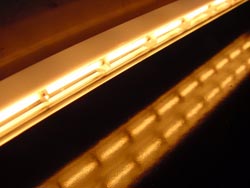New Infrared Emitters Especially Good for Curing Powder Coatings

QRC® Infrared emitters from Heraeus Noblelight being used in tests for powder curing at the Heraeus Noblelight Application Centre. Copyright Heraeus Noblelight 2009<br>
Varnishes and coatings must be dried ever faster and ever more efficiently to meet the market’s increased demands. Drying ovens must be able to handle more and more throughput but not every heating source can keep pace.
The newly developed QRC® infrared emitter (quartz reflective coating) from Heraeus Noblelight helps to melt and cure powder coatings efficiently and can be retrofitted even in particularly tight spaces. Tests show that with the new emitters, process parameters such as temperature and homogeneity are better maintained. This means improved quality, reduced costs and, not least, improved plant energy efficiency.
Powder lacquers are often used to coat metal parts as well as plastics and wood. The lacquer is applied as a powder, is melted by heating it and finally cured. Because of increased production demands and aging heat sources, this process can easily become an expensive and energy-consuming bottleneck, which people do not want to use. Infrared systems are well-suited to increasing the through-put of existing ovens, because infrared technology uses high performance infrared emitters with high heat transfer capacity. Modern infrared systems are very compact so that they can be easily retrofitted in existing plant.
Newly developed QRC® emitters now make it even easier to cope with very little available space. In constricted spaces, the ambient temperature rises but not every heat source can tolerate high temperatures, vapours and gaseous emissions. The QRC® reflector was developed precisely for this by Heraeus Noblelight and this focuses the heat onto the material and maintains its excellent reflectivity over long operating periods.
New Quartz Reflector for Stable Processes
The new QRC® reflector (QRC = quartz reflective coating) developed by Heraeus Noblelight, does not consist of gold or metal oxide but of opaque quartz glass. Quartz glass is extremely heat-resistant and widely resistant to the attack of aggressive substances. Thanks to the very highly diffuse reflection capability of the emitter with the white reflector, heating processes can be stabilised and optimised, as process parameters such as temperature and coating homogeneity can be held better. Because of these constant and stable conditions, the quality of a coating is significantly improved.
And not least, a homogenous heating process helps to reduce costs and increase plant energy efficiency.
Infrared Heat for Powder Coatings
Generally, infrared radiation is very well absorbed by powder. Powder is heated very quickly and is gelled significantly faster than in convection ovens. As there is no air movement, there are no dust inclusions and the powder is not swirled or displaced. Fast melting improves coating quality and increases through-put speed. As infrared heat is transmitted quickly and highly efficiently, in most cases a significantly smaller oven is needed or production throughput can be increased.
Infrared emitters have very fast response times, short wave and carbon emitters from Heraeus Noblelight have response times of the order of one to three seconds. This makes heat controllable and, together with temperature controls, helps to eliminate the overheating of materials. In addition, quick change-over of different types of coating with different burn-in times, is also possible in the same oven. Energy savings are also achieved when the heating source is switched on only when it is needed.
Heraeus Noblelight offers the complete spectrum of infrared heat from extremely short wave NIR to medium wave carbon infrared CIR. Heraeus has more than 40 years experience with infrared emitters and carries out practical tests with customer own materials in its own application centres to establish optimum process solutions.
Heraeus Noblelight GmbH with its headquarters in Hanau and with subsidiaries in the USA, Great Britain, France, China, Australia and Puerto Rico, is one of the technology- and market-leaders in the production of specialist light sources. In 2007, Heraeus Noblelight had an annual turnover of 90 Million € and employed 666 people worldwide. The organisation develops, manufactures and markets infrared and ultraviolet emitters for applications in industrial manufacture, environmental protection, medicine and cosmetics, research, development and analytical laboratories.
Heraeus, the precious metals and technology group headquartered in Hanau, Germany, is a global, private company with over 155 years of tradition. Our businesses include precious metals, sensors, dental and medical products, quartz glass, and specialty lighting sources. With product revenues of € 3 billion and precious metal trading revenues of € 9 billion, as well as over 11,000 employees in more than 100 companies worldwide, Heraeus holds a leading position in its global markets.
Further Information:
Readers:
Heraeus Noblelight GmbH
Reinhard-Heraeus-Ring 7
D-63801 Kleinostheim
phone +49 6181/35-8545, fax +49 6181/35-16 8545
E-Mail hng-infrared@heraeus.com
Press:
Dr. Marie-Luise Bopp
Heraeus Noblelight GmbH,
phone +49 6181/35-8547, fax +49 6181/35-16 8547
E-Mail marie-luise.bopp@heraeus.com
Media Contact
More Information:
http://www.heraeus-noblelight.comAll latest news from the category: HANNOVER MESSE
Newest articles

Hubble Views the Dawn of a Sun-like Star
Looking like a glittering cosmic geode, a trio of dazzling stars blaze from the hollowed-out cavity of a reflection nebula in this new image from NASA’s Hubble Space Telescope. The…

Engineering a new color palette for single-molecule imaging
A new paper published in Nature Nanotechnology outlines a way to create dozens of new “colors” to multiplex single-molecule measurements. Researchers often study biomolecules such as proteins or amino acids…

Using solar energy to generate heat at high temperatures
The production of cement, metals and many chemical commodities requires extremely high temperatures of over a thousand degrees Celsius. At present, this heat is usually obtained by combusting fossil fuels:…





















